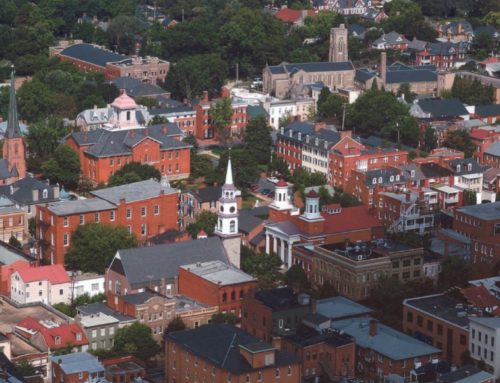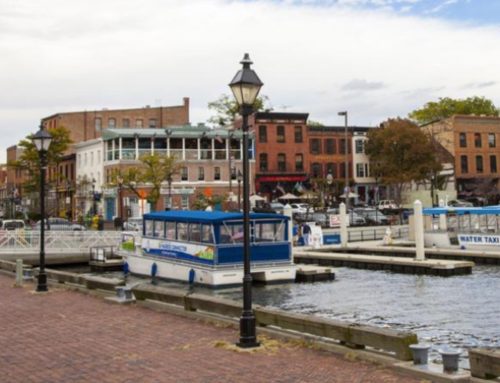Excerpt from Washington Post:
The last time workers came to remake the bridge that carries Takoma Park’s main street across Sligo Creek, safety was not exactly Job One. On a winter’s day in 1932, the crew dynamited a few vital supports, and the bridge promptly collapsed with six workers standing on the span.
Three ran fast enough to make it to safety; three fell 75 feet to their deaths. One, according to a local newspaper account, was crushed so badly that his widow could identify him only by the keys in his pocket.
Now, the workers are back to redo the bridge. They are being more careful, and not just because of eight decades of workplace safety progress. The graceful arched structure that rose after the accident has achieved local landmark status, a picturesque traffic artery above and a keystone feature of the scenic parkland below.
The Maryland State Highway Administration has launched $12 million worth of infrastructure artisanship to preserve the Carroll Avenue bridge. The agency is spending extra money and time rebuilding the span as it is rather than knocking it down (presumably more carefully this time) and swapping it for the kind of faster and cheaper prefabricated replacement currently in vogue with budget-minded civil engineers.
“This one is a little different,” said Maurice Agostino, the state engineer in charge of designing the restoration. “It’s really a character-defining element for the surrounding area. We think it’s important to maintain that character.”
The structure is in for a year of bridge beautification. Its three soaring sets of concrete arches are being restored in place. The upper deck and vertical columns that hold it aloft will be demolished, but crews will custom build molds of laser-carved Styrofoam to re-create its copings, lips and cornices. The ornate side balustrades will be upgraded to a crash-tested design close in appearance to the 1932 version. The new sidewalks will comply with the Americans with Disabilities Act.
On a recent rainy afternoon — as if there has been any other kind this spring — workers crawled about the bridge’s understructure like flies struggling in a web.They had already constructed a massive staging platform halfway up the arches, a 17,000-square-foot floor built on steel beams weighing up to 115 pounds per foot. One crew is stringing a modular steel temporary span across the valley to accommodate pedestrian traffic during the project. Vehicles will be detoured to side streets for up to a year.
“It’s going to be a nightmare, but we’re delighted they are doing it this way,” said Diane Kohn, who lives near the bridge but also runs Historic Takoma, an advocacy group that was among those asking for the structure to be made safe without losing its distinct personality.
On the old arches, workers test the soundness of the 84-year-old concrete by hitting it with a hammer: If it pings, it’s solid. If it thuds, it’s rotten. There have been a lot of thuds; nearly every beam and column is pitted with open concrete wounds oozing rusty stains from exposed iron bones.
Blemish by blemish, crews chip away the old material and polish the metal with high-speed buffers before sealing it off with smooth new concrete.
The bridge is being replaced with the same graceful arches and side rails. (Michael Robinson Chavez/The Washington Post)
Slowly, they are easing the bridge off the highway administration’s “List of Structurally Deficient Bridges.” The agency has 69 bridges on its list. There are separate inventories maintained by cities, counties and the federal government.Nationally, there were nearly 59,000 bridges officially classified as structurally deficient, according to a recent U.S. Transportation Department analysis, including 1,063 in Virginia. None of them are considered at risk of imminent collapse (those bridges are closed). But many, like the bridge over Sligo Creek, have begun to unnerve its users.
“I’ve walked over it in places where you can see the creek through gaps in the sidewalk,” said Kohn.
As complaints mounted, the Maryland Historic Trust and Montgomery County Historic Preservation Commission also weighed in with the highway administration, arguing that the bridge — which is eligible for listing on the National Register of Historic Places — was worth saving.
The state agreed. It’s only the second bridge they have given this kind of preservation makeover. The other was the Route 40 bridge over the Patapsco River west of Baltimore. Preservationists and historians in Takoma Park are delighted to have made the cut.
“Architecturally, it is a magnificent example of how we built bridges back in the time when beauty was part of the equation,” said Lorraine Pearsall, Historic Takoma’s preservation expert.
The bridge was built at a pivotal time for both the town and the region.
Locally, the Seventh-day Adventists — who had relocated their world headquarters from Michigan to Takoma Park — had built a major sanitarium and college on the north bank of Sligo Creek (now Washington Adventist Hospital and University respectively). As the facilities grew, leading families, including the sister of President Warren Harding, constructed some of the first houses on that side of the water. A new bridge was built in 1917 and then replaced with the current span in 1932. Maryland Gov. Albert Ritchie came to open the $60,000 project.
At the same time, local notables, including the family of former U.S. senator Blair Lee, were pushing for the Sligo Creek valley to be preserved as parkland much as Washington’s Rock Creek had been. The state designed the bridge as a scenic feature, its three swooping arches neatly loping over the winding Sligo Creek Parkway on one side, the walking trail on the other and the rocky watercourse in between.
“The [state government] would design arch bridges when they were in a location that was considered scenic,” Charlie Gischlar, a spokesman for the State Highway Administration, said in an email. “The rehabilitation of the bridge is ensuring that it will retain its historic character for another 75-100 years.”


